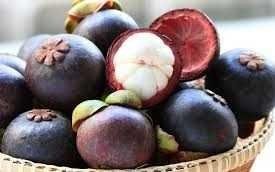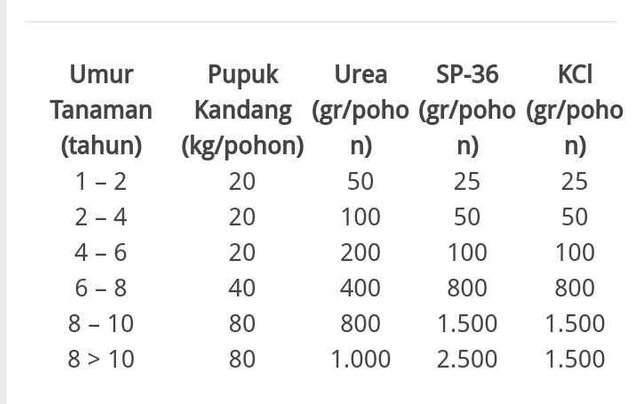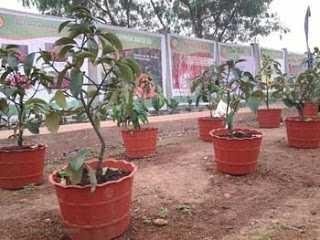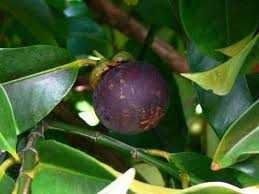Mangosteen and its benefits
Mangosteen fruit trees grow well in the lowlands to an altitude of 800 meters above sea level. Mangosteen trees require optimum air temperature ranging from 22-32 ° C with rainfall intensity 1500 - 2500 mm / year evenly throughout the year and 80% air humidity. The ideal soil type is latosol, well drained, soil pH 5.0 - 7.0 with a depth of soil layer 50 - 200 cm.

Mangosteen is a kind of perennial green tree from tropical region which is believed to come from Archipelago Archipelago. It grows up to 7 to 25 meters. The scientific name of the mangosteen fruit is Garcinia mangostana.
Number of Mangosteen studied (Food Weight) = 100 gr The part of the Mangosteen fruit that can be consumed (Bdd / Food Edible) = 29%
- Mangosteen Fruit Energy = 63 kcal.
- Mangosteen Fruit Protein = 0.6 gr.
- Mangosteen Fruit Fruit = 0.6 gr.
- Fruit Carbohydrate = 15.6 gr.
- Calcium Mangosteen = 8 mg.
- Phosphorus Mangosteen = 12 mg.
- Mangosteen Iron Fruit = 1 mg.
- Vitamin A Mangosteen = 0 IU.
-Vitamin B1 Mangosteen = 0.03 mg. - Vitamin C Mangosteen fruit = 2 mg.
How to Raise Mangosteen Seedlings.
Propagation with mangosteen tree seedlings can use seeds and can also be vegetative such as grafting and grafting grafts. Mangosteen can be propagated by seed but not a generative propagation, because the mangosteen seeds are apomictically formed. Seeds have low viability and rapidly decline. Seed should be added immediately after being taken (removed) from the fruit. If it remains in the fruit, the mangosteen seed survives its viability for 3-5 weeks. The larger the seed the better the growth of the shoots.
Propagation of vegetative mangosteen can be cuttings, grafts, paste, grafting and breastfeeding. The most successful way is done by grafting, that is, shoots. This method is more efficient in using branch entris (top bar). As the bud is used bud buds are still young leaves but has been quite hard. As rootstock seedlings used seedlings that are 2 years old or stem diameter of approximately 0.5 cm, has a green stem bark. The slit connect method works more successfully than the side method.
How to Cultivate Mangosteen Fruit.
- Nursery Preparation.
Mangosteen is propagated through seeds, grafts and shoots. The recommended seeds are seeds from seeds. Benefits of seeds from seeds is a plant has a stout figure of a stout and sturdy, ideal form of crown, high productivity and resistance to disease, but the fruiting age is rather long, about 8-10 years.
- Land preparation.
The land should be clean of stumps, crop residues, trees, shrubs and weeds. Soil treatment is done before the rainy season.
- Planting.
Planting hole made with size 100 x 100 cm x 50 for loose soil. The top quarry is separated by the bottom. Planting hole left open for 2 weeks. Furthermore, the top soil was mixed with 30 kg of manure, 50 grams of urea, 25 grams of TSP and KCl 20 g per planting hole.
To plant the mangosteen the ideal distance is 10 x 10 m, especially for seed seeds, while from the connecting / feeding should be 5 x 5 m. As a cover or protective plant can use a plant banana with a spacing of 2.5 x 2.5 m, so that in 1 hectare of land there will be 100 mangosteen trees and 1500 banana trees. Shade trees should be planted 2 months before the mangosteen crop is planted. For each planted plant should be given mulch from the rest of the plant / leaf under the canopy of the tree, so that the conditions around the plant become moist.
- Watering.
In the early phase of growth, irrigation of plants carried out 1-2 times a day, especially in the dry season so that the soil is always awake humidity. After the plant is older than 2 years, the irrigation interval can be reduced gradually. Watering / watering is done through drip irrigation or using a water hose or aids.
- Pruning.
Pruning is only done on the branches or twigs are dry and pest disease, as well as shoots of water that grow very fast. Pruning care is done after the mangosteen is harvested.
- Pest and Disease Control.
a.Ulat leaf (Stictoptera signifera) Wiggle the young leaves so that they look bare. Control can be performed by spraying Carbaryl insecticide, Bayrusil or Preaccide.
b Fire fire.
Attacking the flowering and fruit-bearing plant. Symptoms of attack seen small holes in the fruit resulting in the release of sap. The skin of the fruit becomes speckled. Control by spraying Carbaryl insecticide, Bayrusil or Supracide at the time of flowering plants until the formation of young fruit.
c.Fungal Disease.
Pestalotia flagisettula, Botrydiplodia sp, harden and when opened the inner skin looks sticky and some of its fruit is rotten. Fungus Pellicularia kolerago Attack on the mangosteen that grows in a sheltered and moist. Leaf color turns brown, dry and brittle.
Fertilization.

A year that is half the dose after harvest and half the dose again before flowering. Fertilizer is given in a circular array 10 - 20 cm deep below the edge of the canopy.
Harvest.
Mangosteen derived from the seeds can be harvested after 8-10 years, while the continued / susangan aged 5-6 years. Harvesting of mangosteen fruit is highly dependent on marketing objectives. Mangosteen for export is harvested at 104-108.
After Flower Bloom (SBM) with the criteria of purple fruit skin reddish pink and the skin is still green by reaching red purple 10-25%, purple red color reach 50%. Mangosteen can be harvested using a pole equipped bag, especially this fruit harvest at the high end of the branch.
Tips on How to Plant in Mangosteen Fruit Pots.
- A good type of pot to grow mangosteen fruit can be from plastic pots or cast pots / cement.
- Prepare pots 40-45 cm in diameter.
- Insert 1. tile or brick at the bottom of the pot to a height of 5 cm.
- Put also planting media into pots in the form of a mixture of manure, soil, and raw husk with a ratio of 2: 1: 1 to a height of half a pot.
- Flush seeds in polybags with water for easy release of seedlings.
- Remove some roots that are too long with a knife or sharp scissors, then enter the seeds right in the middle of the planting hole.
- Backfill with media planting to a height of 2 cm lower than the lip pots.
- Press gently to compress the media.
- Flush the media planted with water, then put in a shade for a week.
- Next, the seeds can be moved into the open in stages.

At the beginning of growth, irrigation is done once a day, especially in the dry season so that the soil is always awake humidity. However, after the plants are older than two years, the irrigation interval can be reduced gradually. Watering is done using a water hose.
Fertilization is done by providing fertilizer NPK 15-15-15 with a dose of 25 grams given 4 months and manure with a dose of 5-10 kg given six months. Fertilizer is given in circular disks 5-10 cm deep by means of immersion or it could be by dissolved with water.
After the plant reaches a height of 1 meter, should the main trunk trimmed by leaving plants as high as 80 cm from the ground. Furthermore, the emerging shoots maintained 3-4 good pieces to produce the primary branch.
The second trimming is done 3-6 months after the first pruning, ie when the shoot height reaches 1 meter. The treatment is the same as the previous pruning. Later, the resulting branch is a secondary branch. So next until the third pruning to produce a tertiary branch so obtained a 1-3-9-27 branching pattern. Production of mangosteen fruit starts from tertiary branching.
Tips to Accelerate Fertilization of Mangosteen Trees In Pot.

To mengerbur flowering outside the season can actually be done. How to provide growth regulators (ZPT), such as KNO3, CEPA, and Paklobutrazol. Unfortunately, flowering often this season produces low quality fruits.
Here is my little knowledge of @boboho for the cultivation of mangosteen fruit, may be useful for all who read this article, see you later with the next article and respectfully from me @boboho.